This German cheesecake or Käsekuchen recipe is a light and creamy quark cheesecake topped with pearled meringue.
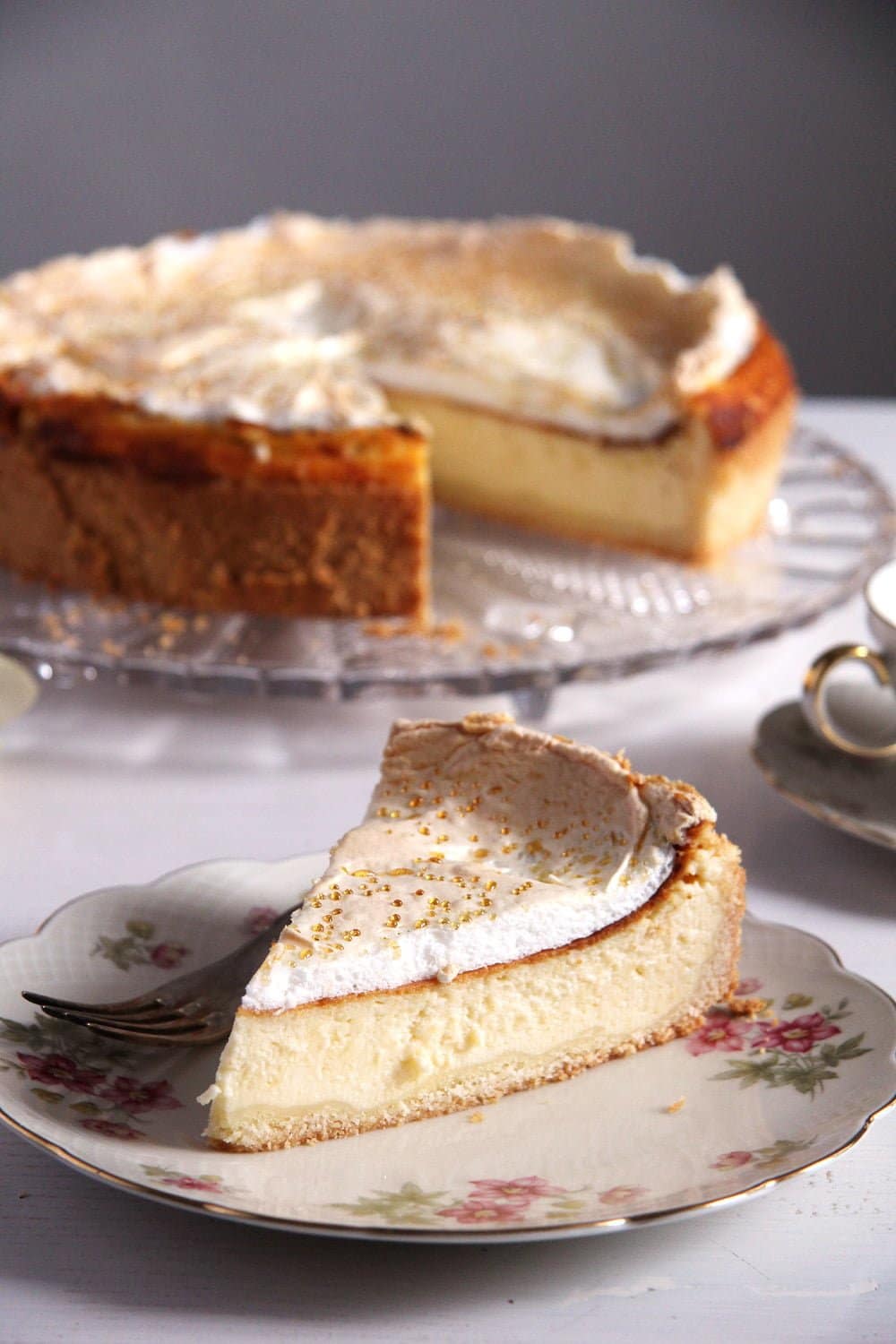
The famous German cheesecake, or Käsekuchen, is a traditional quark cheesecake that can be served with or without the meringue topping. I prefer it with the topping; it makes everything complete.
I think I might have mentioned it before, but I will say it again. I think Germany makes not only the best bread on this planet but also the best cakes.
Think about Schwarzwälder Kirschtorte (Black Forest Gateau), Zwetschgenkuchen (Plum Cake), Apple Crumble Cake (Streusel Cake), Marmorkuchen (Marble Cake) and so on.
Jump to recipe
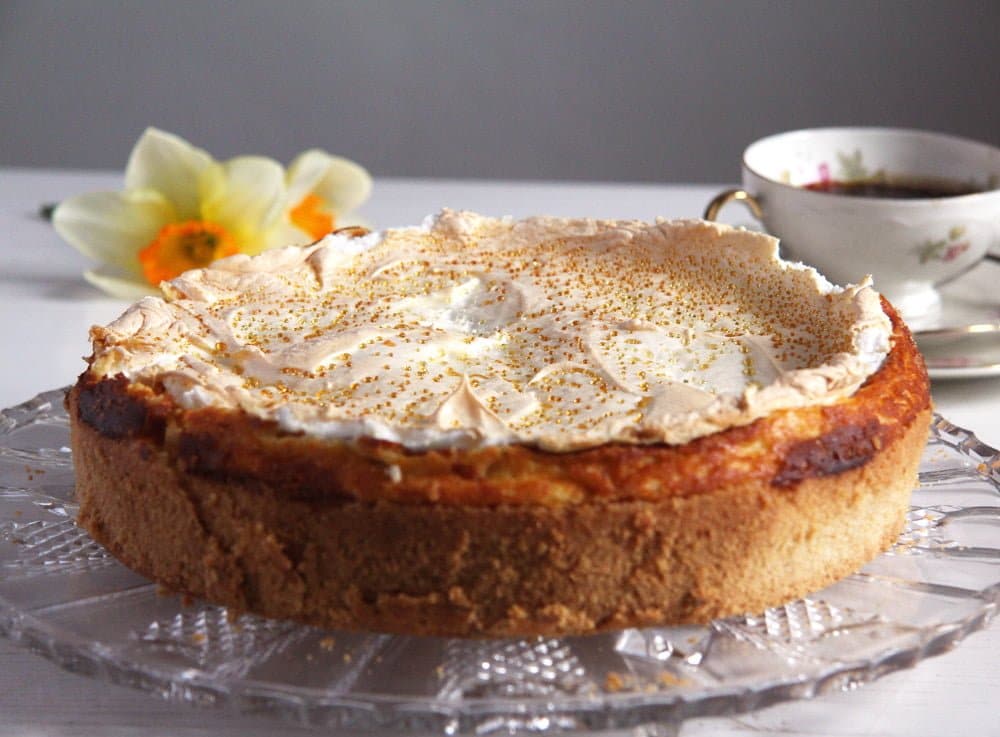
Quark Cheesecake - Käsekuchen
The German cheesecake makes it also to the top of the list, everybody in Germany loves it, everybody knows it, everybody makes it (or buys it).
You can have it in any bakery or cafe; it comes either as it is or with different types of toppings - fruit, sour cream, or meringue topping.
It is the meringue topping that gives this particular version the name of Tränchenkuchen (tears cake).
I usually make the cheesecake with canned mandarins on top; that's the way my son likes it best, but after seeing this version once, I knew I had to make it myself; it just looks so pretty with those sugar tears on top... 🙂 And Bruno loved it anyway, even without the mandarins.
Try this Romanian Easter Cheesecake, next!
What is quark?
- I used low-fat quark to make the quark cheesecake.
- Quark is a fresh dairy product, traditional in the cuisines of German-speaking, Scandinavian and Slavic countries. Quark is protein-packed (½ cup has 11 g of protein in it) and is super healthy especially the low-fat kind.
- Quark is very cheap and very common in Germany, but maybe not that easy to find in other countries. However, most larger supermarkets probably sell quark nowadays; I really hope you can find it because making this German cheesecake with quark is really worth it!
- Quark is similar to Greek yogurt but less tart in taste and slightly stiffer. When it comes to consistency, I think strained yogurt comes closest to quark. When it comes to taste, cottage cheese is a close approximation. However, quark has a slightly stronger taste and is very smooth, while cottage cheese has those little balls in it.
- Usually, I would recommend a substitute for quark, but in the case of this German cheesecake, I think you either make it with quark or let it be.
- This is supposed to be an authentic, traditional cake, which is why no major substitutions should be made. And quark is the main ingredient, after all.
Vanilla pudding powder:
- I use vanilla pudding powder from Dr. Oetker, the one that needs to be cooked with 500 ml/ 2 cups of milk. (Amazon affiliate link)
- However, you will not cook it in this case; just add the powder to the quark mixture.
- The vanilla pudding powder can be replaced with the same amount of cornstarch. In this case, add some more vanilla extract to the filling to intensify the vanilla flavor.
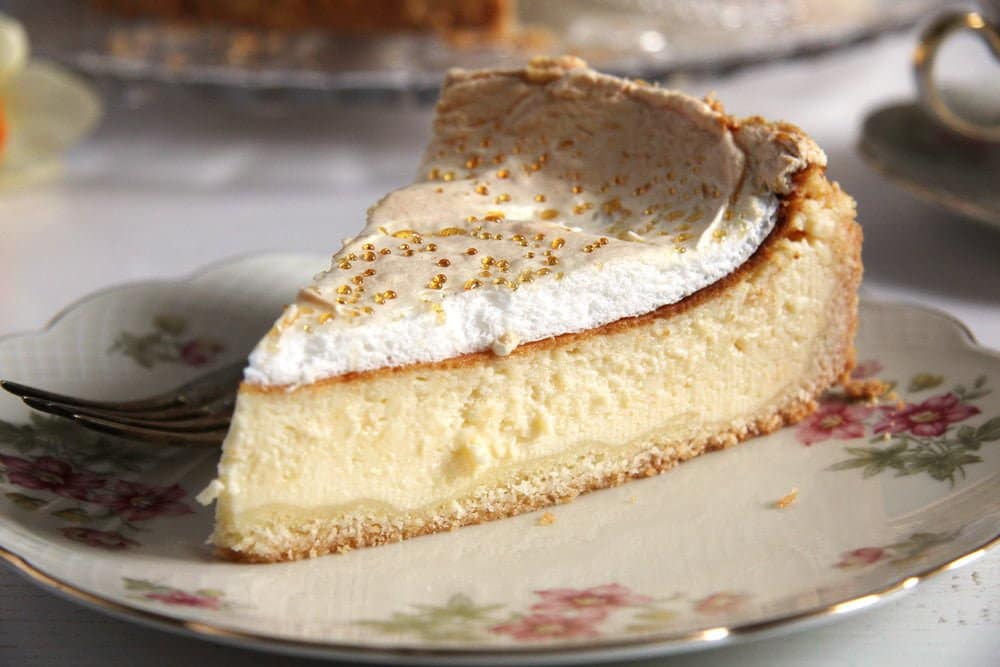
How to bake a quark cheesecake?
I always use the metric system for weighing the ingredients: it is precise, clean, and quick; buying a kitchen scale (the Amazon affiliate link opens in a new tab) is really worth it!!! (Amazon affiliate link). I bought mine for less than 10 euros, and I've been using it for years now.
I also listed the cup measurements because I know that many people only use them. However, I cannot guarantee the best results if you insist on measuring in cups... I know from experience that a cup of flour is not always a cup of flour, if you know what I mean.
And measuring butter in a cup is impossible if you ask me. Not to mention the mess caused by cup measuring... 🙁
Step-by-step instructions
- Preheat the oven to 180 degrees Celsius/ 350 degrees Fahrenheit. Line the bottom of a springform (26 cm/10-inch diameter) with parchment paper and butter the ring.
- Place all the pastry ingredients in a food processor and pulse until you obtain crumbs. Turn the crumbs on the working surface and knead very quickly to form a ball of dough.
- Roll the pastry on the lightly floured surface and place it in the prepared springform, taking care to cover the margins of the form as well.
- Place the quark in a large bowl and whisk it shortly until smooth. Add the rest of the ingredients, mix well, and pour the mixture into the springform. The mixture is pretty liquid, but that is how it is supposed to be.
- Bake the cake for about 70 minutes. After about 60 minutes, start preparing the meringue.
Meringue:
- Place the egg whites and the icing sugar in a very clean bowl and start beating them using very clean whisks.
- After the 70 minutes of baking time are up, take the cake out of the oven and top it with the meringue. Place back in the oven and bake for another 10 minutes.
- Don't leave it for more than 10 minutes, or the tears will not form anymore.
- Don't expect to see the tears already while the cake is still in the oven; the tears will form during cooling.
- Let cool down a little bit, then go around the edges with a knife to release it from the ring. Leave to cool completely on the bottom of the springform.
As with all cheesecakes, the German cheesecake is best served the next day.
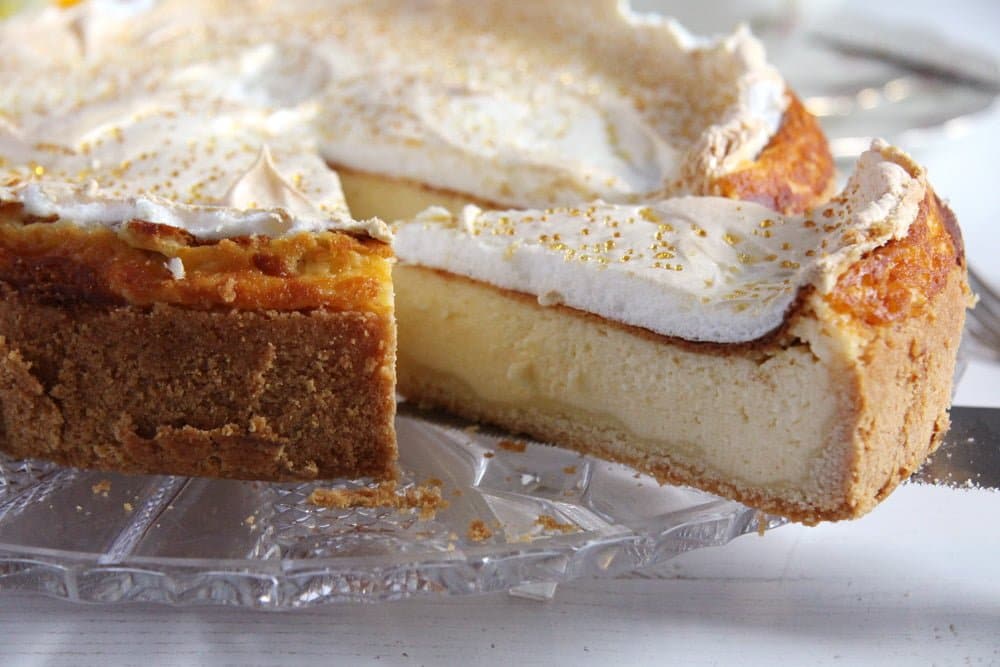
More cheesecakes
Do you like this recipe?
Please leave a good rating in the recipe card below. Stay in touch through social media: Pinterest, Facebook, and Instagram. Don't forget to tag #whereismyspoon when you try a recipe!Recipe
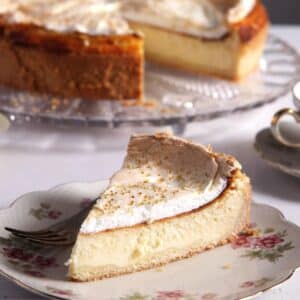
German Cheesecake
Ingredients
Pastry:
- 200 g all-purpose flour 7 oz/ 1 ⅔ cups
- 100 g granulated sugar 3.5 oz/ ½ cup
- 70 g unsalted butter 2.5 oz/ ¼ cup
- 1 egg medium Germany, large US
- 1 teaspoon baking powder
Filling:
- 500 g low-fat quark 1 lb/ 2 ½ cups
- 150 g granulated sugar 5.5 oz/ ¾ cups
- 1 tablespoon vanilla sugar or 1 teaspoon vanilla extract
- 1 packet Dr. Oetker vanilla pudding powder See note
- 1 egg medium Germany, large US
- 2 egg yolks keep the egg whites for the meringue
- 230 ml heavy cream 1 cup
- 230 ml milk 1 cup
- 150 ml vegetable oil scant ⅔ cup
Meringue:
- 2 egg whites
- 6 tablespoons powdered sugar
Instructions
- Preheat the oven to 180 degrees Celsius/ 350 degrees Fahrenheit. Line the bottom of a springform (26 cm/10-inch diameter) with parchment paper and butter the ring.
- Pastry: Place all the pastry ingredients in a food processor and pulse until you obtain crumbs. Turn the crumbs onto the working surface and knead very quickly to form a ball of dough. Roll the pastry on the lightly floured surface and place it in the prepared springform taking care to cover the walls of the form as well.200 g all-purpose flour/ 1 ⅔ cups + 100 g granulated sugar/ ½ cup + 70 g unsalted butter/ ¼ cup + 1 egg + 1 teaspoon baking powder
- Filling: Place the quark in a large bowl and whisk it shortly until smooth. Add the rest of the ingredients - sugar, vanilla, vanilla pudding powder, eggs, egg yolks, heavy cream, milk, vegetable oil - mix well and pour the mixture into the pastry-lined springform. The mixture is pretty liquid; don't worry about it.500 g low-fat quark/ 450 g + 150 g granulated sugar/ ¾ cups + 1 tablespoon vanilla sugar + 1 packet Dr. Oetker vanilla pudding powder + 1 egg + 2 egg yolks + 230 ml heavy cream/ 1 cup + 230 ml milk/ 1 cup + 150 ml vegetable oil/ scant ⅔ cup
- Bake the cake for about 70 minutes. After about 60 minutes, start preparing the meringue.
- Meringue: Place the egg whites and the icing sugar in a spotless bowl and start beating them using very clean whisks. After the 70 minutes are up, take the cake out of the oven and top it with the meringue. Then, place back in the oven and bake for another 10 minutes (only 10 minutes, or you will not have the tears or sugar pearls anymore).2 egg whites + 6 tablespoons powdered sugar
- Let the cake cool down a little bit, then go around the edges with a knife to release the cake from the ring. Leave to cool completely on the bottom of the springform. The tears will form while the cake is cooling down.
Notes
- Always use a digital kitchen scale in baking; it ensures the best results (the Amazon affiliate link opens in a new tab).
- I use the Dr. Oetker vanilla pudding powder, which needs to be cooked with 500 ml/ 2 cups milk. However, you will not cook it in this case; add the powder to the quark mixture. The vanilla pudding powder can be replaced with the same amount of cornstarch. In this case, add some more vanilla extract to the filling to intensify the vanilla flavor.

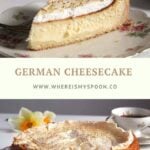
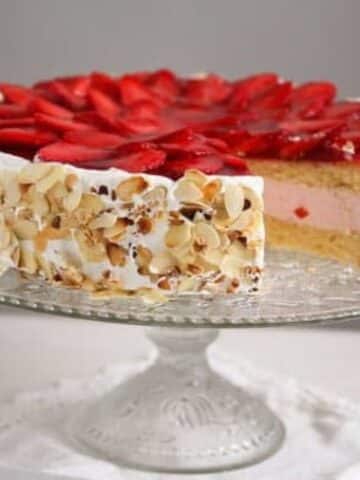
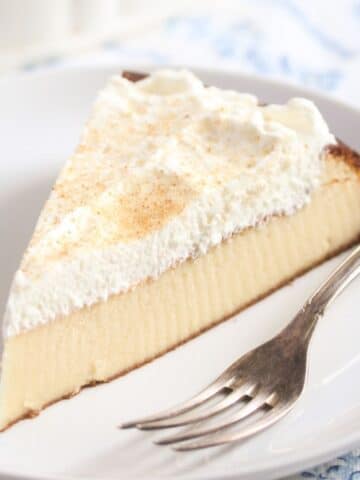
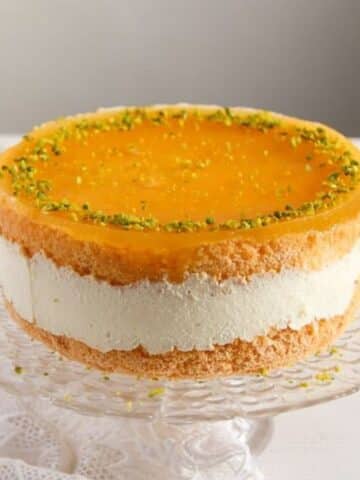
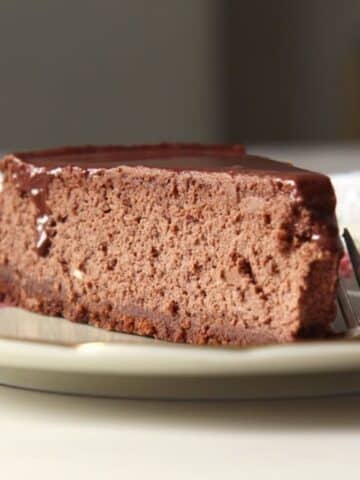
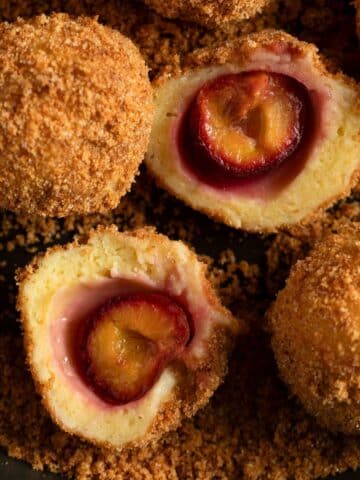
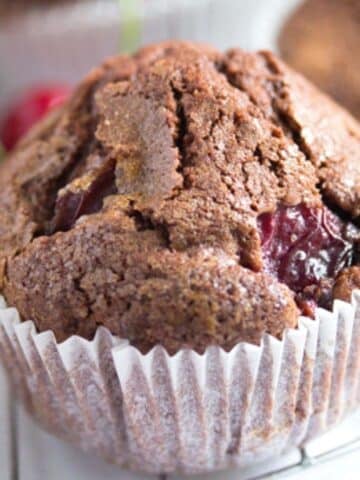
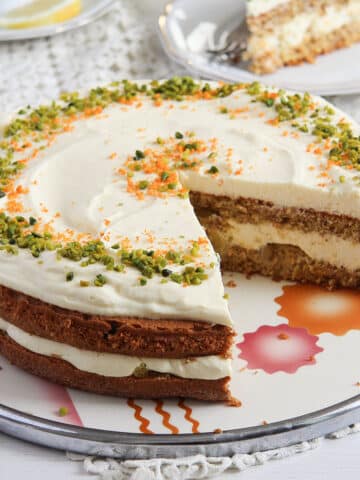
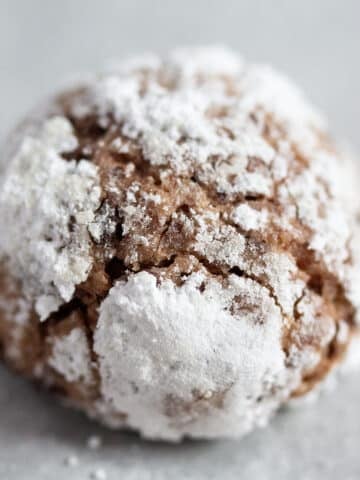

Revi says
Hi Adina. Thank you for this recipe. I'm going to make this cake for a friend who asked for German cheesecake for his birthday. After cooling down, do you keep it in the fridge ? And how long can it last (assuming we won't inhaled it on the evening) ?
Adina says
Hi Revi. Yes, keep the cake in the fridge, covered with some cling film or something. It keeps very well for several days, 3 for sure. Actually I recommend you bake the cheesecake the day before you want to eat, its structure and taste definitely improve overnight.
Cheyanne @ No Spoon Necessary says
OMG, how gorgeous is this cheesecake, Adina!? SOOO pretty! And dangerous, because I could totally eat that entire cake in approximately .3 seconds! SO GOOD! I'm definitely drooling! Cheers!
Anu - My Ginger Garlic Kithcen says
Oh my goodness!!! Beautiful, beautiful. This cheesecake is so gorgeous, Adina! I love the cheesecake and this German cheesecake looks just perfect for the summer!
Balvinder says
Thanks for the interesting post. I was totally unfamiliar with German cheesecake. It really looks marvelous with the meringue topping.
grace says
i've never been a big fan of american cheesecakes, so i'd be very interested in giving the german version a try! 🙂
Angie@Angie's Recipes says
I love the extra meringue topping!
Sissi says
Adina, your cheesecake looks fantastic and (apart from the meringue) it's made more or less like the Polish cheesecake : with the slightly tangy quark, which gives the cheesecake a lighter, more interesting taste and also makes the cake healthier than the US version.
I often prepare cheesecake but I skip the crunchy base because the cheese filling is what I love most!